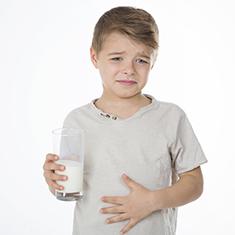
This is a common problem in infants (under 1 year of age). This note should be read in conjunction with the note on food allergy.
The milk allergy can be either an IgE allergy, a non-IgE allergy or mixed. Immediate (<5 minute) skin reactions producing nettle rash (urticarial), swelling and redness (erythroderma) are almost certainly of an IgE mediated.
More commonly an allergy will be a non-IgE type.
The treatment for both types is to avoid the offending allergen (all dairy products) and replace this with a hypoallergenic milk. These milks are effectively pre-digested and break down the allergen to the component parts (as is done in the process of digestion). There are a variety of milks of this type, of varying degrees of palatability.
A very common scenario of milk allergy is colic and reflux or gastro-oesophageal reflux (abbreviated GORD). This is the typically unsettled baby, often pulling up the legs and crying, hungry but also refusing or pulling away from feeds as if in pain (which is actually the case and the baby is in pain), sickly and vomiting and may arch the back in episodes of pain. Sometimes this is described as a baby that cannot wind properly, but actually the problem is much more intuitive than this, the gullet (oesophagus) is burnt by acid reflux. The acid reflux is caused by an upper gut (oesophagus, stomach and duodenum) irritated by milk allergens (proteins that the immune system within the bowel wall, is reacting to). These babies can often do well, if the diagnosis is correct, with a dairy avoiding diet and a hypoallergenic diet with anti-reflux medicines.
It is very common in an exclusively breast fed baby, to have identical symptoms due to cow's milk allergy, due to the delivery of maternal dietary cow's milk proteins within the breast milk. Often non-IgE milk allergy resolves by a year of age, occasionally, even when the diagnosis is correct, only a partial response occurs when dairy avoidance is started. This is often due to the fact that acid damage to the lower oesophagus, impairs the function of the valve at the top of the stomach, leading to more GORD.
A combination of a medical history and examination, a supervised dairy withdrawal, antacid treatment and occasionally some other blood tests (often these are not needed), can enable a secure diagnoses to be made.